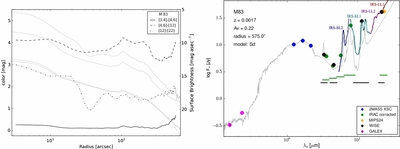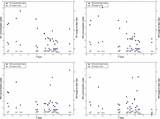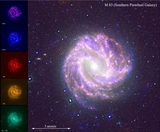Image Details

Caption: Figure 8.
Radial color distribution and global SED for M 83 (NGC 5236). Left: the faint gray lines correspond to the azimuthal elliptical–radial surface brightness. The solid, dashed, and dash-dotted lines correspond to the difference in surface brightness between W1 vs. W2, W2 vs. W3, and W3 vs. W4, respectively. Right: the UV–NIR–MIR SED for M 83, including GALEX, 2MASS XSC, IRAC, MIPS, and WISE photometry, corrected for the foreground Galactic extinction ( A v = 0.22 mag). The spectra are from SINGS Spitzer/IRS (SL and LL modules) of the nucleus. The gray line is an Sd galaxy model, adapted from the GRASIL code (Polletta et al. 2006, 2007; Silva et al. 1998) normalized to the near-IR. The IRAC, MIPS-24 and WISE bandpass widths are indicated with solid green and black lines, respectively.
Copyright and Terms & Conditions
© 2013. The American Astronomical Society. All rights reserved.












